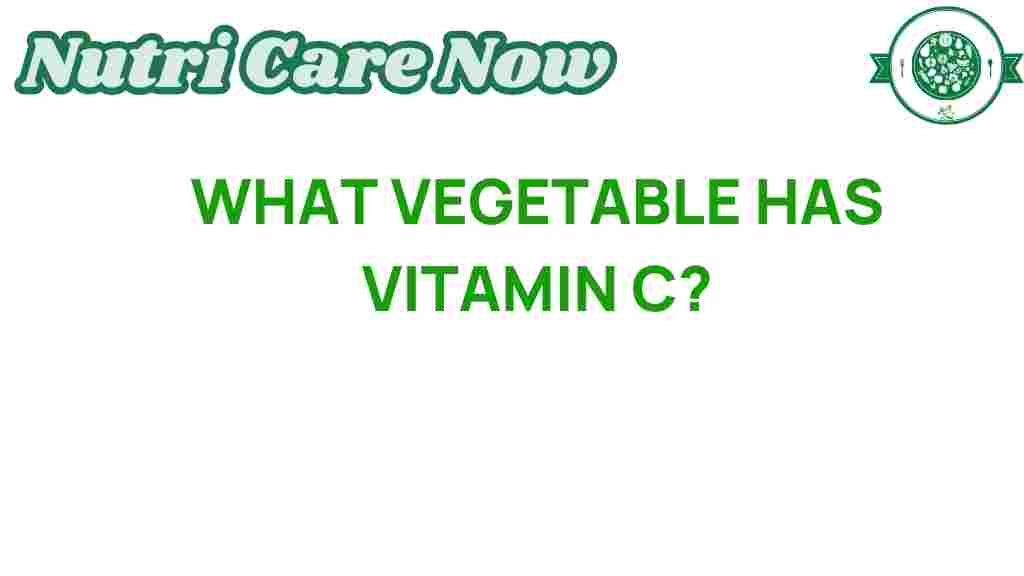Uncover the Surprising Vegetable Packed with Vitamin C
When it comes to maintaining a healthy lifestyle, the importance of vitamin C cannot be overstated. This essential nutrient is renowned for its role in supporting the immune system, promoting skin health, and acting as a powerful antioxidant. While many people associate vitamin C primarily with fruits, particularly citrus fruits, there are numerous vegetables that are excellent sources of this vital nutrient. In this article, we will delve into the surprising vegetable that is packed with vitamin C, explore its health benefits, and provide tips on incorporating it into your diet.
The Power of Vitamin C
Vitamin C, also known as ascorbic acid, is a water-soluble vitamin that plays several critical roles in the body. Its functions include:
- Immune Support: Vitamin C enhances the production of white blood cells, which are essential for fighting infections.
- Antioxidant Protection: It protects cells from damage caused by free radicals, which can lead to chronic diseases.
- Collagen Synthesis: Vitamin C is crucial for the production of collagen, a protein that helps maintain skin elasticity and joint health.
- Improved Iron Absorption: It aids in the absorption of non-heme iron from plant-based foods, making it especially important for vegetarians and vegans.
In addition to these benefits, a diet rich in vitamin C can lead to overall improved health and well-being.
Surprising Vegetables High in Vitamin C
While many people think of oranges or strawberries when they hear “vitamin C,” there are several vegetables that are actually higher in vitamin C content. One standout vegetable is:
Bell Peppers
Bell peppers, particularly the red variety, are an exceptional source of vitamin C. In fact, one medium red bell pepper can contain over 150 mg of vitamin C, which is more than twice the Recommended Dietary Allowance (RDA) for adults. Here’s a closer look at why bell peppers are a fantastic addition to your diet:
Why Bell Peppers Are Nutritional Powerhouses
- Rich in Antioxidants: In addition to vitamin C, bell peppers contain various antioxidants, including flavonoids and carotenoids, which contribute to overall health.
- Low in Calories: Bell peppers are low in calories, making them an excellent choice for weight management.
- Versatile in Cooking: They can be eaten raw, cooked, or roasted, making them easy to incorporate into various dishes.
- High in Fiber: Bell peppers provide dietary fiber, which aids in digestion and promotes a healthy gut.
How to Incorporate Bell Peppers into Your Diet
Incorporating bell peppers into your meals is easy and delicious. Here are some simple ideas:
- Salads: Add sliced or diced bell peppers to salads for a crunchy texture and vibrant color.
- Stir-Fries: Include bell peppers in stir-fries with other vegetables and lean proteins.
- Stuffed Peppers: Create stuffed bell peppers with quinoa, beans, and spices for a nutritious meal.
- Snacks: Enjoy raw bell pepper slices with hummus or guacamole for a healthy snack.
Other Vegetables Rich in Vitamin C
Besides bell peppers, there are several other vegetables worth noting for their vitamin C content:
- Broccoli: A cruciferous vegetable that offers about 81 mg of vitamin C per cup when cooked.
- Kale: This leafy green provides around 80 mg of vitamin C per cup and is also high in other nutrients.
- Brussels Sprouts: They contain about 75 mg of vitamin C per cup and are a great source of fiber.
- Cauliflower: With approximately 52 mg of vitamin C per cup, cauliflower is another versatile option.
Understanding Dietary Sources of Vitamin C
To ensure you’re getting enough vitamin C, it’s essential to diversify your food choices. Here are some excellent dietary sources:
- Fruits: Oranges, strawberries, kiwis, guavas, and papayas are rich in vitamin C.
- Vegetables: Aside from those mentioned, spinach, tomatoes, and sweet potatoes also contribute to vitamin C intake.
- Supplements: While it’s best to obtain nutrients from whole foods, vitamin C supplements are available for those who may need them.
Potential Troubleshooting Tips
While incorporating more vitamin C-rich foods into your diet can be beneficial, consider the following tips to maximize absorption and effectiveness:
- Fresh is Best: Vitamin C is sensitive to heat, light, and air. To preserve its content, consume vegetables raw or lightly cooked.
- Combine with Iron: To enhance iron absorption, pair vitamin C-rich foods with iron-rich foods, especially for plant-based diets.
- Store Properly: Keep fruits and vegetables in the refrigerator to maintain their vitamin C levels for longer.
Conclusion
In conclusion, the surprising vegetable packed with vitamin C is the bell pepper, particularly the red variety. This colorful vegetable is not only rich in vitamin C but also offers a plethora of health benefits, including immune support, antioxidant properties, and dietary fiber. By incorporating bell peppers and other vitamin C-rich vegetables into your meals, you can enhance your nutrition and overall health.
Remember, a balanced diet filled with a variety of fruits and vegetables will provide the essential nutrients your body needs to thrive. For more information on nutrition and healthy eating, check out this resource. Start exploring the world of vegetables today to discover new ways to boost your vitamin C intake and reap the numerous health benefits that come with it!
This article is in the category Health and created by NutriCareNow Team
